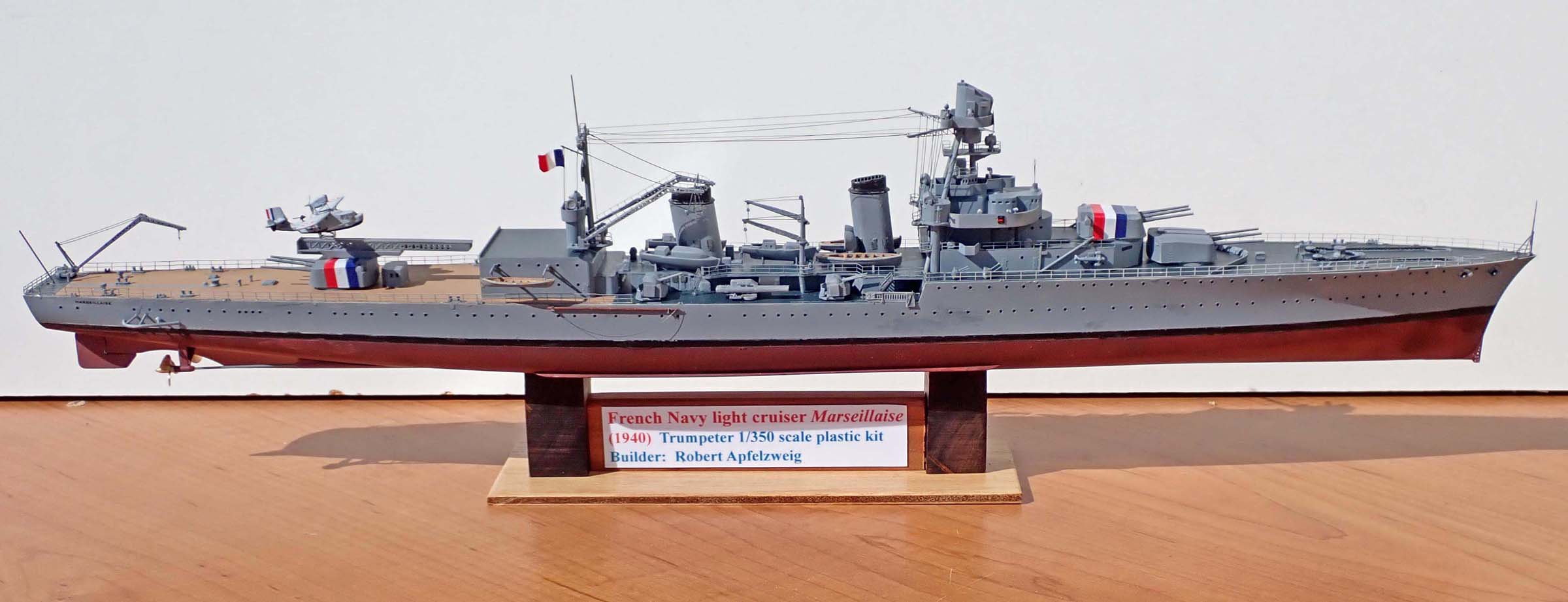
1/350 Marseillaise 1940 (Trumpeter)
|
by Robert Apfelzweig |

1/350 Marseillaise 1940 (Trumpeter)
This kit is one of Trumpeter’s most recent releases, and I was eager to build a model of a relatively obscure (for builders in the USA, anyway) but interesting and visually attractive model warship. This vessel was one of six La Galissonnière-class cruisers built after 1935, the last pre-World War II cruisers to be built for the French Navy. Three survived the war, and three did not, including Marseillaise –these being scuttled, along with most of the French fleet, in Toulon Harbor in November 1942 to avoid their falling into the hands of advancing German troops. The Marseillaise was commissioned in October 1937 and within a few months joined France’s Mediterranean fleet. Following the outbreak of World War II she was stationed in Toulon, and participated in the transport of French gold to Canada in April 1940. Following France’s surrender to the Nazis in late June 1940, she remained in Toulon until her scuttling.Trumpeter’s kit is a relatively easy build, with generally excellent fit of the two deck segments and the one-piece hull; the only difficulty I had was installing the hangar, as its forward edge had to be filed slightly to get it to fit snugly against the rear superstructure. The kit includes an adequate photoetch set that provides enough 2-bar railing to meet requirements, but the assembly instructions omit the fact that, on the main, deck, there should be no railing between the two pairs of 90mm AA guns – if the railing is installed to be continuous all the way to the stern, there will not be quite enough. Also, there is no separate railing segment for the lower searchlight platform just forward of the mainmast, though this is easy enough to fashion from any of the several long railing segments provided. The Loire 130 floatplane is provided in clear plastic (a Trumpeter favorite, it seems) but I scratch-built it with narrow photoetch segments and a couple of stretched sprue pieces to replace the incorrect plastic pegs provided that attach the small wing pontoons to the underside of the wings (there are numerous online photos of this type of aircraft, including completed models, to serve as a guide), as well as the rear-facing machine gun. I also used a spare photoetch catapult carriage. Perhaps in a few months there will be a photoetch upgrade set for this model (it wouldn’t require much to improve it) that will have brass cranes and the catapult, which remain plastic and the only significant deficiency in this kit. The nine 152 mm (6-in.) guns (10 are included in the kit as individual barrels, rather awkwardly attached to the sprue by the middle of the barrel) have hollowed-out muzzles and are meant to be able to elevate individually. The light AA fitting in the kit consists of 4 twin 37-mounts. I was uncertain as to their scale in the kit, but a close look at several online photos of this ship show that they seem to be quite accurately sized, even though as closed gunhouses they are quite small and I can’t imagine how a gunner would fit inside them with their breeches and ammunition on hand. The twin plastic barrels are not very accurate – they are paired together, whereas photos of the actual 37 mm guns (at least as reproduced in 1:72 scale CAD images) show that the barrels were one above the other with the lower one slightly askew to the right. I had no French 37 mm brass barrels so I used spare Italian and German ones. The rigging was made from stretched plastic sprue, and paints from Tamiya acrylics (sometimes mixed to get a closer approximation of the painting scheme provided with the assembly instructions).
The only other issue I had is that the photoetch clocks/range clocks for the foretop and mainmast, based on both period photos and even the box art, are oversized, though I don’t think that I could make the hour marks around the edges any clearer if I had needed to make them any smaller. These clocks should probably be about 2mm narrower in diameter and their faces provided as decals. Some online photos apparently show this warship as she appeared in 1942, somewhat upgraded with a raised forward funnel cap, a small mast top the foretop and what may be additional small AA guns (perhaps quad 13.2-mm mounts) on top of the hangar, which was just vacant space, without even railings, in the 1940 version.
